Filippo, Abraham.
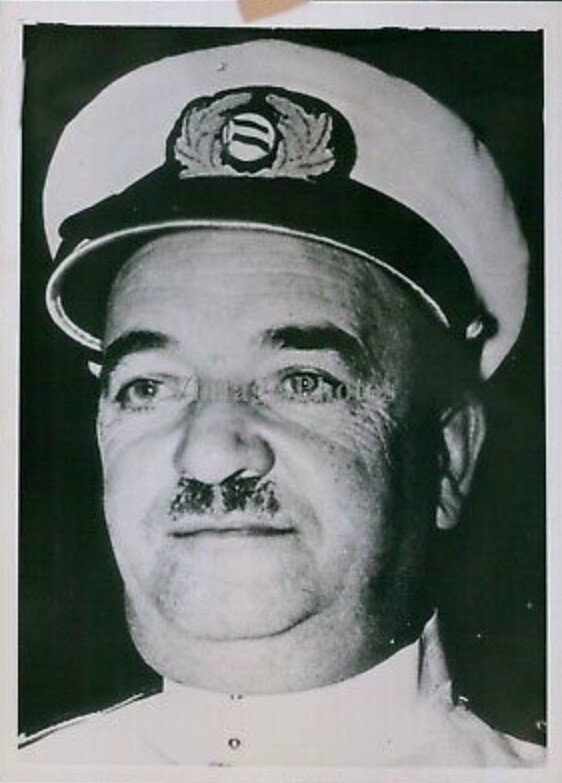
Captain Filippo. Later in his career in white uniform. (a)
Captain Abraham Filippo.
Born: 6 December 1884 at Leiden, the Netherlands. There was one brother who disappeared (details unknown) during World War 1. His daughter was then raised by Captain Filippo and his wife. The captain and his wife did not have any children.
I do not have much information yet about his private life until Family and Friends respond and help me out. Please contact the editor on Captalbert1@aol.com.
He married on 02 Oct. 1921 in Oestgeest with Anna Josephina Francisca Sengers. (13 May 1887 – 14 November 1969) It is unclear why they married outside Rotterdam; maybe for the family as Oestgeest is just outside Leiden where the captain was born.
After a Maritime Academy schooling he joined The Holland America Line on 12 January 1903 as a cadet. His year as cadet was fully spent on the passenger ships, which was somewhat unusual as in 1900 the company had started to add cargo ships to the fleet and since then most cadets did half / half to get the best all round training possible.
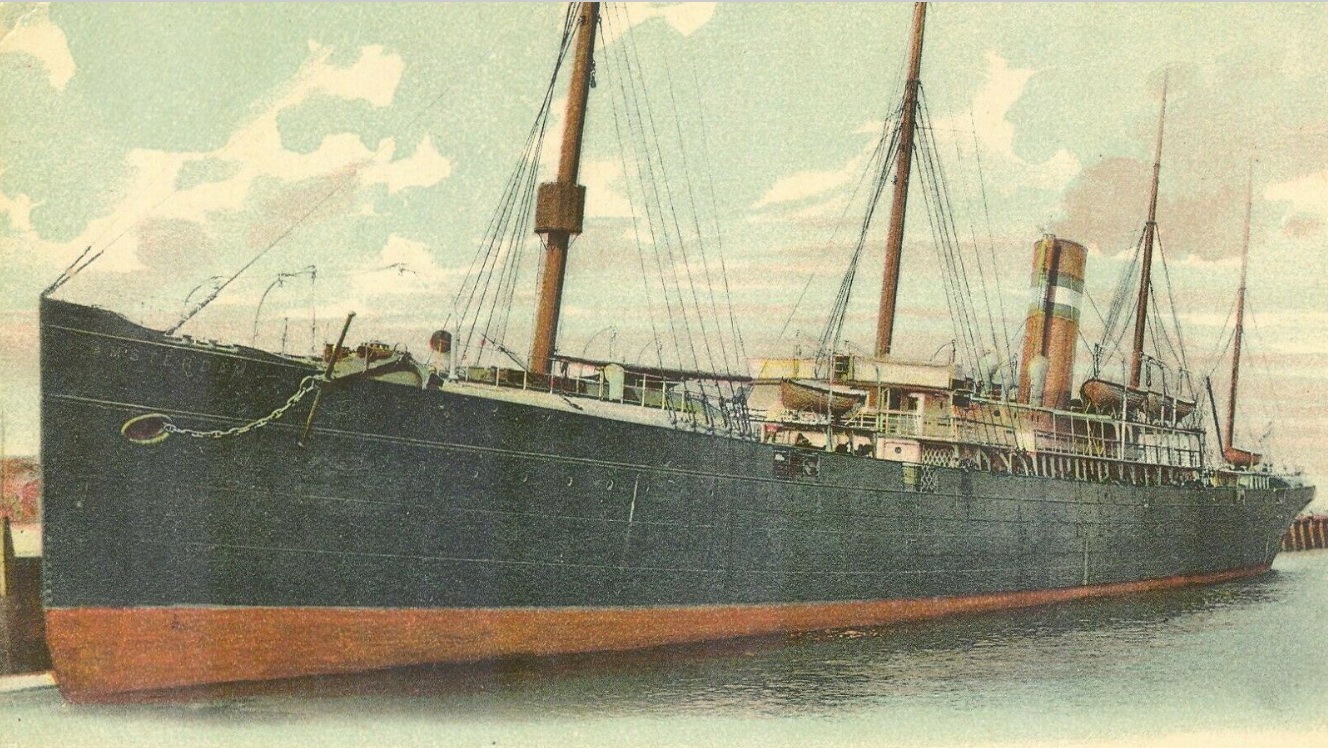
The ss Amsterdam (II) by 1903 an old ship in the fleet but still in service focusing on the emigrant trade. Last of an era she was sold to Italy for scrap in 1905 (Picture from a cotemporary postcard (a))
He obtained his 3rd mates’s certificate in December 1903 and then returned to Holland America. Here he spent most of his time on the passenger ship with only an occasional diversion to the cargoships. His most regular assignment was on the ss Rijndam (I)
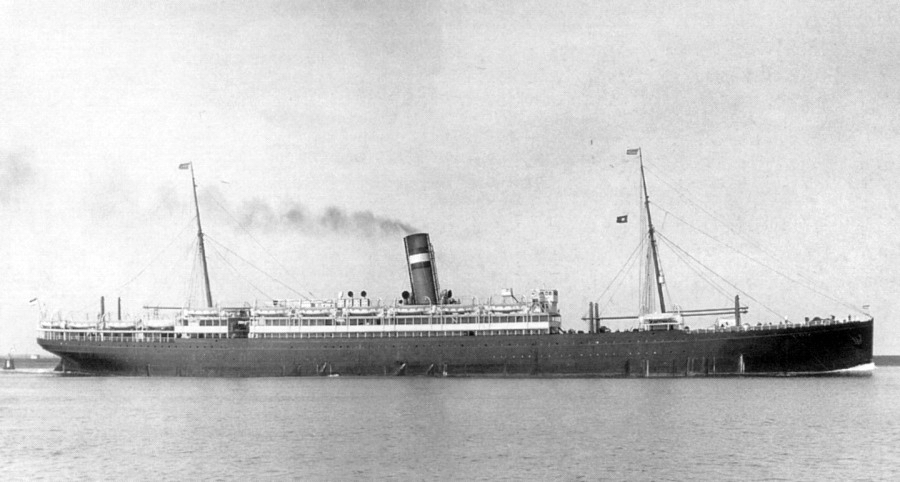
The ss Rijndam (I) seen here on the Nieuwe Waterweg or New Waterway which gave access to the port of Rotterdam. This photo is from later in her career when a Wheel house was added. Officer Filippo had to withstand all the elements while keeping his watches during the voyages.
Progress through the ranks was quickly and he made captain in 12 years’ time. Of course you need a bit of luck and that is what he got as the company was expanding quite rapidly at that time. His first command was the Soestdijk (I) in 1914 and that brought him also into the newspapers for the first time. In August 1914 he returned towards Europe from Philadelphia (voyage 82) and then the war broke out. With limited communication it was not exactly known what was going on but –all lights out – was required against the submarines. What an unharmed merchant ship can do anything against a submarine is doubtful but if you are going to get shot at then the Captain should be on the bridge. So the newspapers were very impressed that he remained for more than 72 hrs., without a break, on the bridge to ensure that a VERY sharp look out was kept. The ship was stopped three times and inspected, by British Warships but was allowed to continue unhindered and after having received the latest information about the location of mines in the shipping lanes mad it home safely.
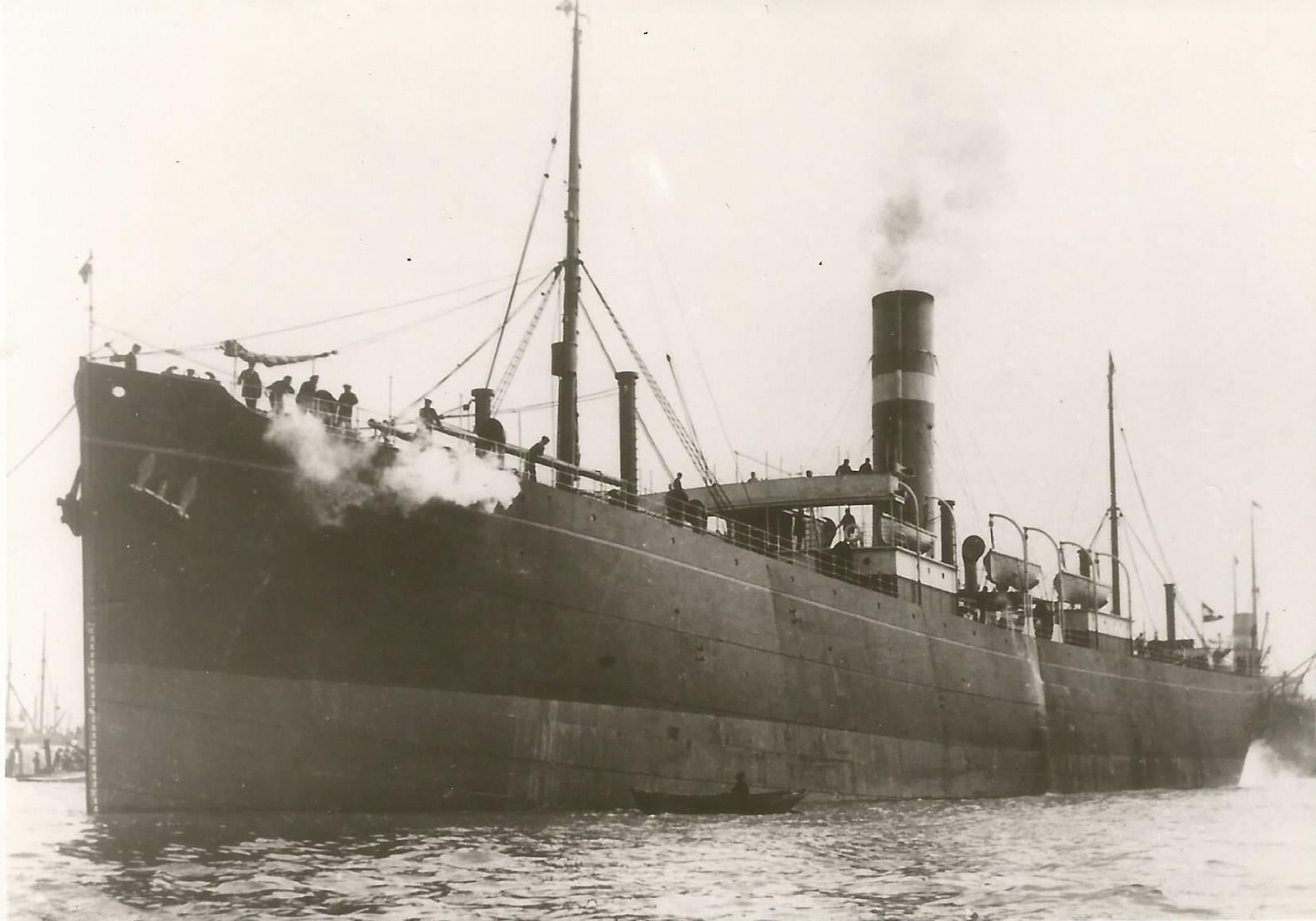
The claim to fame for the ss Soestdijk (I) was that she was the first cargo only ship built for the company. In the late 1890’s it was decided to split the fleet in dedicated cargo ships and dedicated passenger ships. A policy that was kept until 1921 when the “Edam” class arrived.
To be added. Anything through the years of this career.
While captain of the ss Noorderdijk (II) between 1924 and 1927 he had the honour to open the new Canadian Pacific Railway B.C Pier in Vancouver on 27 Oct. 1926. Canadian Pacific was a company which had ships on the North Atlantic, railroads through Canada and then ships on the North Pacific. So they were able to offer an inhouse service from Great Britain all the way to Japan. By the early 20’s their terminal A in Vancouver was becoming too small and then they started by 1924 an building much larger terminal B-C. this terminal & docks was demolished in the 1980’s and at its location is the Vancouver Cruise terminal “Canada Place”. Still in use by Holland America Line ships. (d)
The most important part of his life, at least from an historical point of view was not his period at sea, but what he did during the war. He had just arrived home with the ss Veendam (II) and it was not possible to get the ship back to sea when the invasion started. Thus he was stuck in Rotterdam and quite quickly got involved with the Dutch Resistance. He started up the “Zeemanspot” which was a banking system so that families of sailors who were out at sea would still receive money to live on.
Most of the information below I have lifted out of an article Mr. Laurens van der Laan, for the magazine “Hallo” for the Dutch Association of old Holland America Line Employees. A few notes have been inserted to put a few things in better perspective for those who are not familiar with the Dutch History.
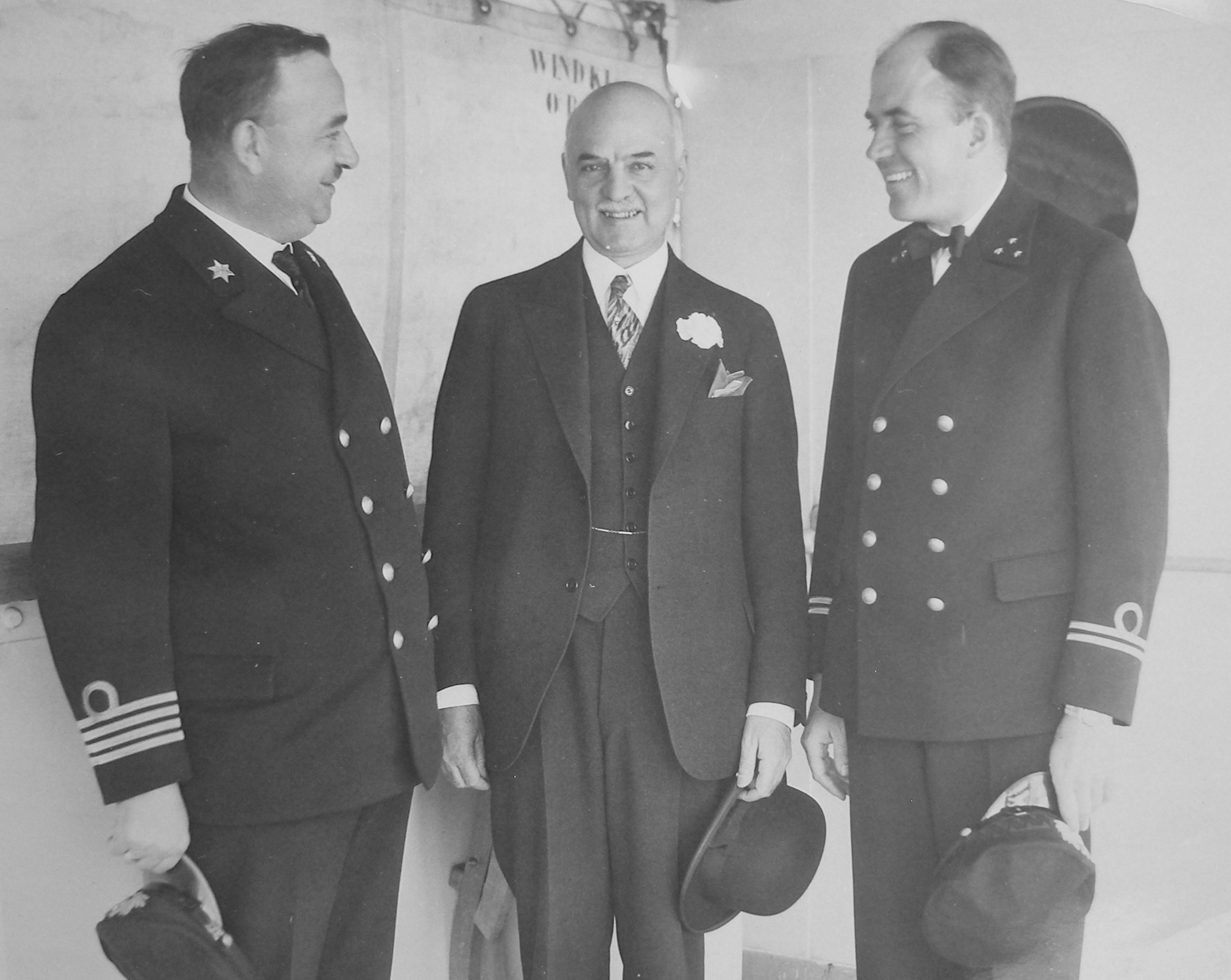
Captain Filippo sometime in the 30’s with somebody who must have been very important. The gentleman to the right is a 2nd officer. Date of photo and names of other persons unknown. (a)
When Captain Abraham Filippo on 06 May 1940 docked his ship the ss Veendam (II) at the Wilhelminakade, little did he know of what importance he would be for a large number of people in the following years. Same as with the First World War, The Kingdom of the Netherlands was planning to say neutral during this conflict, thus nobody was really prepared for what happened on the 10th of May. The ss Veendam (II) together with some other ships was docked for a regular turn around in the port. And as an invasion was not expected, none of these ships had been prepared for a quick departure.
But the invasion did happen, and here starts the story.
The Captain managed to get a car from a local garage and when he drove into Rotterdam he saw that the Germans where already there and were stopping cars who wanted to cross the only bridge that gave access from the North to the Southbank. But they were not everywhere, so he could drive on, and just missed the little ferry that ran from the north side of the river Maas to the Wilhelminakade where the Head office and the ships were. Some of the office people were on that ferry. He also tried to get a tugboat and even a sightseeing boat for transport.
Before any arrangements could take place the Royal Marines arrived and they started shooting at the Germans and so the captain was ordered to leave. Once away from that area he met up with the captains Moree (ex Captain of the mined Binnendyk), Kleyn (Captain on leave from ss Edam (IV)) and Vlietstra (Captain ss Drechtdijk), various deck officers, engineers and more office personnel. He established contact with one of the Directors Mr. Bouman. This gentleman had managed to get to the head office before the Germans had closed the bridge. Captain Filippo, with the others were now directed to get enough crew together to get the ss Veendam (II) and Boschdijk back to sea. By the time they had crew it would still take 4 hrs. to raise enough steam. By then it was too late as Mr. Bouman was advised by the Harbourmaster that German airplanes had dropped magnetic mines in the Nieuwe Waterweg (the 22 mile long channel between Rotterdam Port and the open sea) and that put a stop to the sailing plans.
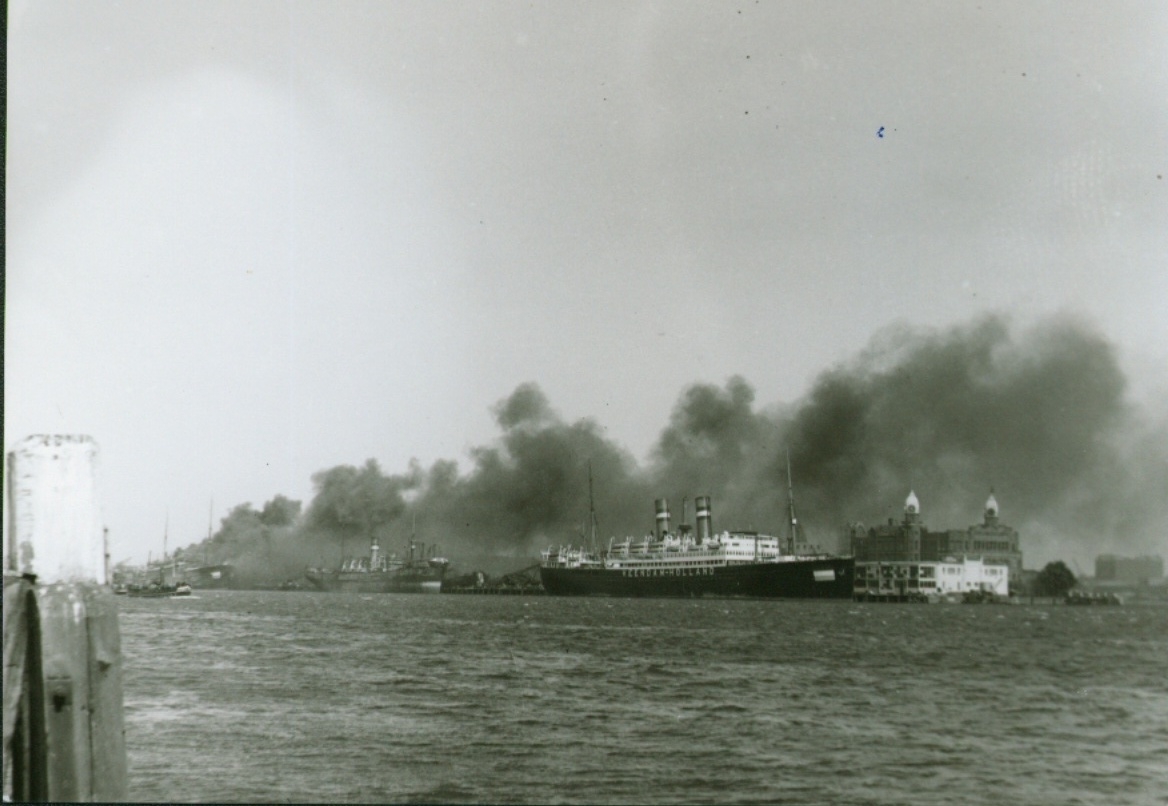
The outbreak of the war and the fight in the port. The ss Statendam (III) is on fire and so is the cargo ship ss Boschdijk. the ss Veendam (II) was not damaged and was subsequently used in Hamburg as a Submarine crew hotel ship. (a)
As the shooting intensified Mr. Bouman then decided to evacuate everybody from the Wilhelminakade and they left with the HAL tugboat Amerika for the North shore of the river Maas after the Harbourmaster had arranged with the Dutch troops not to shoot at the tugboat. Approx. 50 volunteers remained in the vicinity of the company’s buildings and ships with the aim to try to protect them from the fighting; fire hoses were brought into readiness. But eventually they also had to leave. The fighting then caused the Boschdyk and Statendam (II)) to catch fire as well as most of the cargo sheds. (The main office and the Veendam (II) at the head of the pier remained unscathed) The two damaged ships were later sold for scrap, while other ships which were also damaged could be salvaged and were taken over by the Occupiers, after May 15 when the Netherlands capitulated. This capitulation was mainly caused by the fact that from the afternoon of the 14th. Of May the City center of Rotterdam was bombed. The Dutch Government did not have an answer against so much brutality so they capitulated to stop the bombing.
With the capitulation a fact, many Dutch Merchant Navy ships were outside the country and could not return. They became part of the Allied War effort and these ships and crews would not see the mother country again until 1945 and some not until 1946. While at sea, the normal procedure to forward the wages of all these sailors was for their company to send a standard amount each month, called an allotment, to their homes or bank account. When the sailor then returned and that could sometimes be after 8 or 9 months, the final balance was made up, before the next voyage started. Now about 18,000 sailors were in this position and many of them had families in Rotterdam.
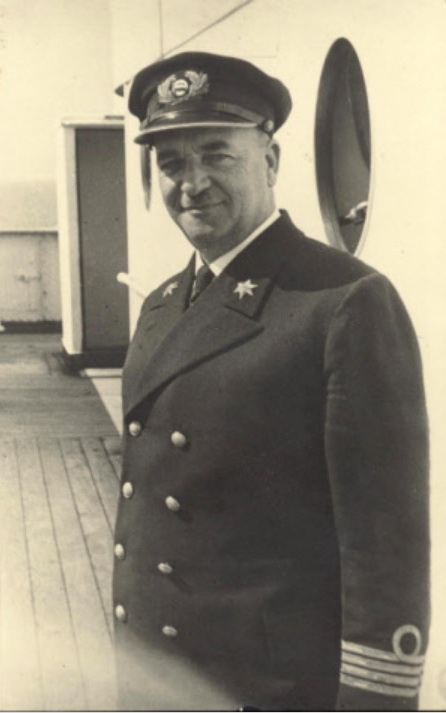
Captain Filippo on board his last ship the ss Veendam (II)
In the beginning of the war the Occupation Government let this system continue without much interference but what could a company management do if they were not in control of the ships outside the occupied zones. After a while the occupier became more involved (read = made things more difficult) and people started to resist against what was starting to happen. The Cashier of Holland America started to get more requests from family’s whose husband was at sea, to be allotted more money, or if there was not allotment at all ( not unusual for those who were on the regular Rotterdam – New York service with the passenger ships) to get one. The cashier could not just do that as the money had to come from somewhere while the trade in Rotterdam had virtually come to a standstill for the HAL so not much money was coming in.
When Captain Filippo became aware of this dilemma he decided to start raising funds outside the official system so women and families could still receive, where needed, some money. He received moral support from Mr. Bouman to move forward with the plan.
Several Captains and other Colleagues offered their help and support and he received guarantees from leading persons in various places in the Netherlands for support as well and slowly but steadily a complete network of “illegal supporters” came into being. These were called “voogden” or in English “Guardians”. All the monies received, large or small, either a donation or a loan, from companies, friends or acquaintances were handed over to the Captain and his “Central Bank” became known as the “Zeemanspot”
“Zeemans Pot” translates in Seaman’s Pot and is a Dutch word to describe a collected or subscribed amount of money, put in escrow to mutually benefit sailors. Before the war there were already various local variations of these “pots” to support sailors as a sort of insurance against calamities. The captain then started to send regularly amounts of money to the other Guardians in the country. This money was sometimes send by postal order but often in cash. And it was not usual to have somebody travelling with a small suitcase full of bank notes. These Guardians then who knew the local sailor families in need, then took care of the delivery of the money.
Everybody had to be very careful to ensure that the Occupier of the Netherlands did not know anything about it as they certainly did not approve of it; the official point of view was, those sailors out there were the enemy and thus those left behind should suffer. To keep it all confidential the Captain – known in the system under the pseudonym Captain Abrahamse – insisted that the Guardians should only focus on their work for the “Zeemanspot” and should not get involved in any other resistance work. There was a considerable chance of getting caught or being betrayed. To reduce that chance to the minimum the Guardians were only known by their nickname and did not know each other.
In April 1941 the Occupation Government announced that it was no longer allowed for shipping companies to hand out allotments to the sailor families. Only money from charity drives would still be allowed. This had an enormous impact on the money flow to these families and resulted in the fact that a lot of people, reacting with great indignation, decided to get involved with financial or other support. By June 1941 the Dutch Government in London announced on the Dutch Radio (Radio Station Orange = Radio Oranje) that they encouraged any activity that would help the affected families. As a result everywhere people started to collect money for families they knew. By September 1941 the Occupier really started to clamp down on the allotment system of the shipping company’s and if they did not stop, than this would be considered sabotage. (Normally good for the death penalty)
This meant that the activities of the “Zeemanspot” were greatly extended. The captain received visitors who were involved with the various shipping company’s and/or did similar work as the Guardians. It took a bit of doing but when combining forces, they were able to draw up a list of around 1900 families in the Rotterdam area who could benefit from donations. A book keeper was appointed, the only one with a salary. (When the war was over it would take him several years to completely bring everything to a good end.)
By the end of 1941 the USA had joined the war, Japan started to overrun the east and by the spring of 1942 the occupier tightened the rules even further; now also the families of Royal Navy personnel were affected.
Around this time Capt. Filippo met Mr. Walraven van Hall a banker from the city of Zaandam. (He had started his career as a navigation officer and had then gone into banking. But he still felt a close connection to the shipping world and its current troubles) He had been busy with several others to setup a National Fund (NSF) for families of sailors of the coaster trade, the towing business and the fishing fleet but also sponsored illegal activities and supported those who had gone in hiding (The Dutch called this “going underground”). The Dutch Government guaranteed that the monies that were handed out (on loan upon final settlement of wages after the war for the sailing families) would be paid back. This fund now wanted to work together with Filippo and the “Zeemanspot” but the captain was not very enthusiastic about it. The bigger the system, the bigger the chance of being found out. But he did agree that the N.S.F would take over the district of Amsterdam. This area had become very complicated to handle as one of his Guardians there had been arrested.
District Rotterdam under his leadership was enlarged when in May 1942 the Royal Navy Officers were send away as Prisoners of War; and it was even more enlarged when in 1943 the families supported by the “Tromp Fonds” (based on donations from the southern part of the country) were included as the Manager of that Fund was becoming more and more focused on other illegal activities.
Near the end of 1943 the war started to turn into the favour of the Allied Forces and The Dutch Government ordered a general strike of the Dutch Railways to stop the train transports of the Germans. The Captain had been preparing for the fact that the last part of the war might be extremely difficult and had provided his guardians with a “Victory fund” in case regular communication would become a big problem. It was tried to continue transfers by money order as much as possible but the lack of Postal employees (A lot of the male postal employees where either in Germany for forced labour or had gone “underground”) did not make that easy. Difficulties continued when in August 1944, Chief Engineer J.H Verbaan who had handled District The Hague since the beginning was arrested and send to a concentration camp in Germany where he died. The Netherlands, after operation Market Gardens, was now partly liberated (the area below the Rivers Maas and Rhine) but the rest to the north would remain occupied territory until May 1945. This area would suffer a very hard winter with little food and very little support from the outside. At the same time the funds of the “Zeemanspot” were depleting severely.
Help was needed from the Rotterdam business world and that came. Money and goods (Clothing, Shoes, potatoes, tulip bulbs, sugar beets, etc. etc.) was collected and could (very stealthily) be obtained at one of the sheds of Holland America where it was distributed by yet another company man. (The shed next to this was one was in use by the Germans but they never noticed anything. The organizers sometimes even managed to divert deliveries meant for the Germans to the —other—shed)
In the spring of 1945 Captain Filippo fell ill, it is said that the constant stress of the dangerous work partly caused this. Understandable if one takes into consideration that at least 11 people who were connected to “De Zeemanspot” lost their lives. Captain Moree who had been helping throughout the war took officially over until he himself returned to sea. Soon after liberation day, there was an official recognition for all the hard work that the Captain had done but unfortunately he passed away shortly after on the 17th. of September 1945.
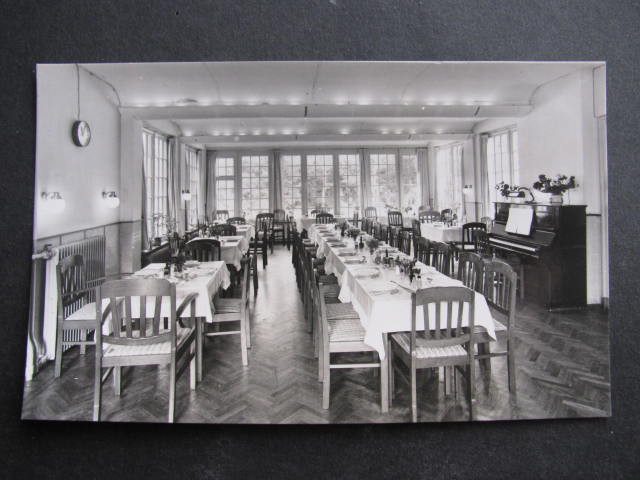
The main dining room of the vacation home “De Witte Hull “was named after Captain Filippo. (a)
When the final balance sheet of the “Zeemanspot” was made up it became clear that there was about 1 mln. guilders left; while over 5 mln had been forwarded to those in need. (To put that in 20th. Century money, multiply by 10) and this all without the Occupational Forces really getting a handle on the system. Now the function of the “Zeemanspot” was changed into a benevolent society and with the monies left an Estate was bought in the town of Zeist called “Witte Hull”. It was operated as a convalescent and vacation resort for families of those who had perished at sea during the war. The Main Dining room was named after Captain Filippo. This vacation home was sold in 1966 and the financial result was split along the two Dutch Volunteer Lifeboat Societies. One had a new lifeboat built which was named “De Zeemanspot”. (The Witte Hull still exists and was not so long ago converted in apartments). (c)
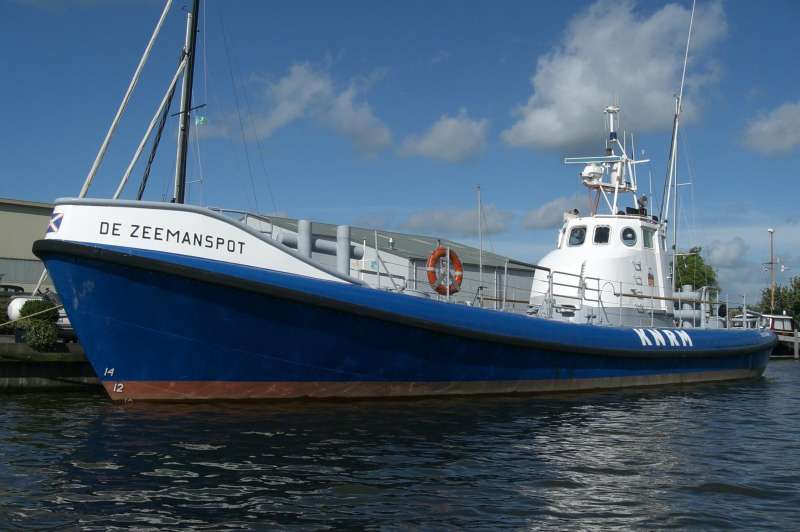
The lifeboat bought with the money left over from the Zeemanspot funds. The lifeboat is now a floating museum and can be visited and even trips can be made with the boat as she is fully operational www.mrbdezeemanspot.nl. Photo from this website.
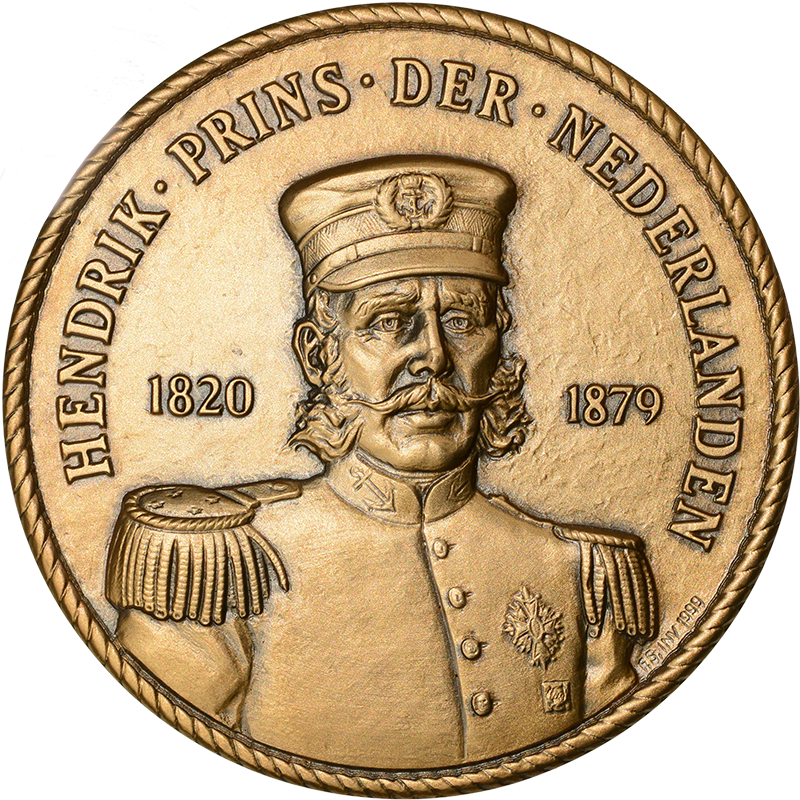
The (Dutch) Royal Navy “Prins Hendrik legpenning”
A belated recognition of this work arrived on the 2nd of October 2021 when Mr. van Walraven van Hall and Captain Filippo where honour by the Dutch Royal Navy with the Prins Hendrik medal. This is a commemorative coin which is awarded by the Royal Navy to non Navy persons who have made a significant impact on maritime live. The medal for Filippo was handed out to Mr. Jan Karel bout Grand son of Captain Filippo and for Van Hall to his grand daughter Julie Habraken.
Note: Prins Hendrik or Prince Henry was a Dutch Royal and the brother of the Dutch King in the 1870’s. His nickname was the “seafarer” as he sailed with the Dutch Royal Navy to all the corners of the Dutch Empire. In the Netherlands he promoted the development of the railways and was also the Sponsor of the foundation of the Holland America Line and bought the first share that was issued in 1872. As his interests bridged the spheres the Royal Navy and the Merchant Navy, it was decided to name the medallion after him when the Royal Navy honoured people from the Merchant Navy.
Career Time Line: (b)
Date: Function: Ship: Wages and/or remarks.
12 Jan. 1903 Cadet Amsterdam 10,–
09 Jun. 1903 Cadet Rijndam 15,-
09 Oct. 1903 Temporary dismissed to go to school for 3rd mates license. Passed on 16 Dec. 1903
30 Dec. 1903 4th. Officer Rijndam 30,–
01 Feb. 1904 4th. Officer Statendam 30,–
20 Mar. 1904 Into hospital in Falmouth England arrived
05 Aug 1904 Back in Holland and went home.
30 Nov. 1904 4th. Officer Rotterdam 30,–
18 Aug. 1905 Temporary dismissed due to illness
13 Sep. 1905 4th. Officer Rijndam 40,–
22 Nov. 1905 4th. Officer Rijndam 40,–
03 Jan. 1906 Act. 3rd Officer Potsdam 40,–
14 Feb. 1906 Act. 3rd officer Nieuw Amsterdam 40,–
16 May. 1906 Act. 3rd officer Statendam 40,–
11 Oct. 1906 Temporary dismissed to go to school for 2nd mates license. Passed 12 Dec. 1906
21 Dec. 1906 3rd Officer Soestdijk 50,–
08 Oct. 1907 2nd Officer Statendam 60,–
25 Nov. 1907 2nd Officer Rijndam 60,–
05 Sep. 1908 2nd officer Jr. Nieuw Amsterdam 60,–
28 Dec. 1908 2nd officer Jr. Statendam 60,–
14 Mar. 1909 Temporary dismissed to go to school for 1st mates license. Passed 21 May 1909
26 May 1909 Chief Officer Maartensdijk 100,–
20 Jan. 1910 Chief Officer Statendam 100,–
09 Mar. 1910 Chief Officer Potsdam 100,–
15 Apr. 1910 Chief Officer Gorredijk 100,–
01 Jan. 1911 Due to wage review 140,–
11 Jan. 1912 Wage increase 150,–
07 Oct. 1912 Wage increase 160,–
26 Mar. 1913 Wage increase 180,–
26 Mar. 1913 Chief Officer Rijndam 180.—
05 Oct. 1913 Wage increase 190,.—
08 Jan. 1914 Act. Captain Soestdijk 250,– But not promoted
09 Dec. 1914 Promoted to Captain
09 Dec. 1914 Captain Soestdijk 250,–
08 May. 1915 Temporary ashore due to illness of his wife.
31 May.1915 Captain Sloterdijk 250,–
27 Aug. 1915 Captain Soestdijk 250,–
16 May.1917 Temporary shore
19 Sep. 1917 Captain Sloterdijk 250,–
07 May.1918 Captain Zijldijk 250,–
01 Aug. 1918 wage increase 300,–
01 Oct. 1918 Captain IJseldijk 300,– with the N.A to New York
01 Jul.1919 Wage increase 625,–
01 Jan. 1920 Wage increase 650,–
15 Oct. 1920 Wage increase 675,–
01 Jun. 1921 Temporary ashore
20 Jul. 1921 Captain Beukelsdijk 675,—
22 Sep. 1921 Temporary ashore
17 Oct. 1921 Captain Gorredijk 675,–
16 Oct. 1921 wage decrease 610,–
24 Dec. 1921 Temporary shore
30 Dec. 1921 Captain Hoogkerk 610,– Holl. Br. Ind. Line
16 Feb. 1922 Temporary ashore
22 Feb.1922 Captain Gorredijk 610,–
21 Apr. 1922 Captain Breedijk 585,–
20 Mar. 1924 Temporary ashore (operation)
01 Sep. 1924 Captain Noorderdijk 585,–
01 Apr. 1927 wage increase 605,–
07 Jun. 1927 Temporary ashore 605,– by boat from Liverpool
16 Jun. 1927 Captain Noorderdijk 605,–
20 Jun. 1927 Captain Dinteldijk 605,–
06 Feb. 1928 Captain Noorderdijk 605,–
06 Feb. 1928 won the silver medal of the Royal Netherlands Meteorological Institute,
23 Jun. 1928 Captain ashore 605 on leave
27 Jun. 1928 Captain Noorderdijk 605,– per Batavier to London
01 Jan. 1929 Wage increase 625,–
01 Jul. 1929 Temporary ashore 625,–
15 Aug. 1929 Captain Drechtdijk 625,–
Receives the gold medal from the Royal Netherlands Meteorological society.
04 Dec. 1929 Captain Leerdam 625,–
01 Jan. 1930 Wage increase 645,–
21 May.1930 Temporary ashore 545,–
30 May. 1930 Captain Delftdijk 645,–
Sailed from May 1928 to May 31: 2 years and 10 months.
19 May.1931 Temporary ashore 645,–
21 Oct. 1931 Captain Drechtdijk 645,–
06 Feb. 1932 Wage decreased 516,–
01 Jun. 1932 Temporary ashore 70% 516,-
12 Jul. 1932 Captain Damsterdijk 516,–
01 Nov. 1932 Wage decreased to 466,–
28 Jun. 1932 Wage decreased with 5% according to circulaire No 929 dated 27 June 1933
28 Dec. 1932 Wage decreased with 5% according to circulaire No 929 dated 27 June 1933
01 Oct. 1934 Wage decreased 403,–
12 Mar. 1936 Temporary ashore 403,– regular leave
In conjunction with the new regulations for captain the wage is from 1 march 1936
Increased to 415,– see circulaire accounting date 18 April 1936
20 Apr. 1936 Captain Veendam 415,–
30 Oct. 1936 Temporary shore 415,–
23 Nov. 1936 Captain Veendam 415,–
10 Apr. 1937 Temporary ashore 415,– on leave
29 Apr. 1937 Captain Veendam 415,–
30 Sep. 1937 Temporary ashore 415,–
01 Oct. 1937 Wage increase 460,– acc. new arrangement
07 Oct. 1937 Captain Statendam 500 for one voyage
29 Oct. 1937 Captain Veendam
12 May. 1939 Captain Nieuw Amsterdam
For one voyage until 30 may to replace Capt. Bijl
30 May. 1939 Captain Veendam
16 Jun. 1939 Captain Volendam until 11 Jul
07 Dec. 1939 Captain Veendam 15 Jan. 1940
until 06 May 1940
Was stuck with his ship in Rotterdam when the German Invasion started.
————-
Sources:
(a) Photos Author’s collection / unknown internet sources.
(b) The career listing comes from the “Stamboeken” and “Movement boeken” from the Holland America Line archives, as held by the Municipal Archives in Rotterdam.
(c) De Zeemanspot story originates from an article of Mr. Laurens van der Laan, Rotterdam,.
(d). Information provided by Mr. Floris van Weelderen, Vancouver.
Last Updated: 122 September 2022.

March 18, 2019 at 11:15 am
Beste Captain Albert Schoonderbeek,
In het zakboekje van mijn vader, steward op de ss Veendam in de jaren 38-40, trof ik i.d.d. de naam aan van kapitein Filippo van 26-8-1939 t/m 9-5-1940. Daarvoor was kapitein v Hemert bevelvoerder. Indrukwekkend was het verhaal dat de ss Veendam te hulp schoot bij de ondergang van het vliegdekschip HMS Courageous op 17 september 1939, 19.50 hrs, 190 miles sw of Dursey Head, Ireland. De Veendam draaide alle reddingssloepen naar buiten, 4 gingen de zee op en pikte het scheepslogboek en 1 drenkeling (die kort daarop overleed) op uit de met dikke olie besmeurde zee. 555 zeelui en vliegers verloren het leven door de aanval van de U-29.
Het is bewonderenswaardig dat kapitein Fillippo een illegaal netwerk heeft onderhouden ter financiële steun van families van omgekomen of onbekend afwezige zeelui ten tijden van de oorlog. Een held dus!
March 18, 2019 at 10:25 pm
Dank U voor het lezen van mijn blog. Ja tzt komt het hele fillipo verhaal uitgebreid op de blog testaan. De man is kort na de oorlog overleden
en toen Holland America in de jaren 50 een aantal woon flats bouwde voor hal personeel in Dordrecht, toen heeft men een flat naar de kapitein vernoemd. DE flat is er nog steeds.
mvg
Kapt. Albert
June 2, 2019 at 12:26 pm
Who knows when and where captain Abraham Filippo (the man of the “Zeemanspot”) was born and died? Nowhere to find!
Thanks!
pnugter@xs4all.nl
June 3, 2019 at 6:47 pm
thank you for reading my blog.
I will post some more details in the near future, as he is one of the captains I have not posted a biography off.
Best regards
Capt. Albert
October 22, 2019 at 6:03 am
Abraham Filippo was born in Leyden, Dec. 6, 1884, joined HAL in Jan. 1903 and was appointed temporary captain of the freight ship SOESTDYK in Jan. 1914. On his return from Philadelphia to Rotterdam in Aug. 6 , his ship was stopped and searched by two English navy ships and thus found that WW1 had started. In Dec 1914 followed his definite appointment. During WW1 The Netherlands was a neutral country, like the United States.
WW2 started in Sept. 1939 and The Neth. invaded in May 10, 1940. Capt. Abraham’s ss VEENDAM arrived from NY on May 8. During the war – at home- he initiated an ‘underground’ fund called ‘Zeemanspot’ (Sailor’s pool) to support the families of those on ships outside the occupied country. The war ended May 5, 1945 and Capt. Filippo died that year on Sept. 17.
His ship was requisitioned by the ‘Kriegsmarine’; found heavily damaged and towed back to Rotterdam in Jan. 1946. Her first ‘maiden’ post-war arrival at New York, March 4, 1947, Capt. Pieter Lagaay.